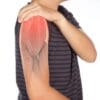Understanding Shoulder Pain: Could It Be Shoulder Joint Tenosynovitis?
Introduction
Shoulder pain is a common issue affecting many individuals, often disrupting daily activities and reducing quality of life. While several conditions can lead to shoulder pain, one often overlooked cause is shoulder joint tenosynovitis. But what exactly is tenosynovitis, and how does it affect the shoulder joint?
What is Shoulder Joint Tenosynovitis?
Tenosynovitis is the inflammation of the fluid-filled sheath (synovium) that surrounds a tendon. This condition can affect any tendon in the body, but when it targets the shoulder, it specifically impacts the tendons of the rotator cuff or the biceps tendon. The inflammation can cause pain, swelling, and difficulty in moving the shoulder.
Causes of Shoulder Joint Tenosynovitis
1. Repetitive Motion
Activities involving repetitive shoulder movements, such as swimming, painting, or lifting, can lead to overuse of the shoulder tendons, causing inflammation.
2. Injury or Trauma
A direct injury to the shoulder, such as a fall or sudden impact, can damage the tendons and lead to tenosynovitis.
3. Inflammatory Diseases
Conditions like rheumatoid arthritis or gout can cause inflammation in the tendons, resulting in tenosynovitis.
4. Infections
Although rare, infections can also cause tenosynovitis, especially if there is a cut or wound near the shoulder.
Symptoms of Shoulder Joint Tenosynovitis
1. Pain
The most common symptom is pain, which can be sharp or dull. The pain often worsens with shoulder movement or at night.
2. Swelling
Inflammation of the synovium can cause noticeable swelling around the shoulder joint.
3. Limited Range of Motion
The inflammation and pain can restrict shoulder movement, making it difficult to perform tasks like reaching overhead or lifting objects.
4. Warmth and Redness
In some cases, the affected area may feel warm to the touch and appear red due to inflammation.
Diagnosis of Shoulder Joint Tenosynovitis
1. Physical Examination
A doctor will perform a thorough physical examination, checking for tenderness, swelling, and range of motion.
2. Imaging Tests
X-rays, MRI, or ultrasound may be used to get a detailed view of the shoulder joint and identify any inflammation or damage to the tendons.
3. Blood Tests
If an inflammatory disease or infection is suspected, blood tests may be conducted to identify any underlying conditions.
Treatment of Shoulder Joint Tenosynovitis
1. Rest and Immobilization
Resting the shoulder and avoiding activities that cause pain can help reduce inflammation. In some cases, a sling may be used to immobilize the shoulder.
2. Medication
Anti-inflammatory medications, such as NSAIDs, can help relieve pain and reduce inflammation. In severe cases, corticosteroid injections may be administered.
3. Physical Therapy
A physical therapist can design a tailored exercise program to strengthen the shoulder muscles, improve flexibility, and reduce pain.
4. Surgery
In rare cases where conservative treatments fail, surgery may be required to remove inflamed tissue or repair damaged tendons.
Preventing Shoulder Joint Tenosynovitis
1. Proper Technique
Using proper techniques during activities and exercises can help prevent overuse injuries.
2. Strengthening Exercises
Regularly performing shoulder strengthening exercises can help maintain tendon health and prevent inflammation.
3. Ergonomic Adjustments
Making ergonomic adjustments to workspaces or sports equipment can reduce strain on the shoulder tendons.
Download Fitpaa for a Pain-Free Life
Understanding and managing shoulder joint tenosynovitis can be challenging, but with the right tools and support, you can achieve a pain-free life. This is where Fitpaa comes in.
Personalized Health and Fitness Plan
Fitpaa offers a comprehensive health and fitness plan tailored to your needs. Our expert team, including fitness coaches, nutritionists, and doctors, will design a personalized Fitpaa Capsule to help you achieve your health goals.
Real-Time Guidance and Support
With Fitpaa’s real-time guidance technology, you’ll receive timely nudges and support throughout the day to stay on track with your fitness plan. The app’s virtual workout trainer, diet tracker, and performance tracking features make it easy to follow your plan and achieve your goals.
Guaranteed Results
At Fitpaa, we promise guaranteed results. Our scientifically designed Fitpaa Capsule activates every cell in your body, releases the right hormones, and helps you achieve your fitness goals without compromising your health.
Free Trial and Risk-Free Subscription
Experience the benefits of Fitpaa with a 7-day risk-free trial. If you don’t see the promised results, you can cancel anytime within 7 days and get a full refund, no questions asked.
Join the Fitpaa Community
Join the growing community of Fitpaa users who have transformed their lives and achieved their health and fitness goals. Download the Fitpaa app today and take the first step towards a healthier, pain-free life.
## Conclusion
Shoulder joint tenosynovitis can be a painful and debilitating condition, but with the right diagnosis and treatment, you can manage your symptoms and prevent future flare-ups. By downloading the Fitpaa app, you’ll have access to a personalized health and fitness plan, real-time guidance, and the support of a dedicated team to help you achieve your goals with guaranteed results. Don’t let shoulder pain hold you back—take control of your health with Fitpaa today.









